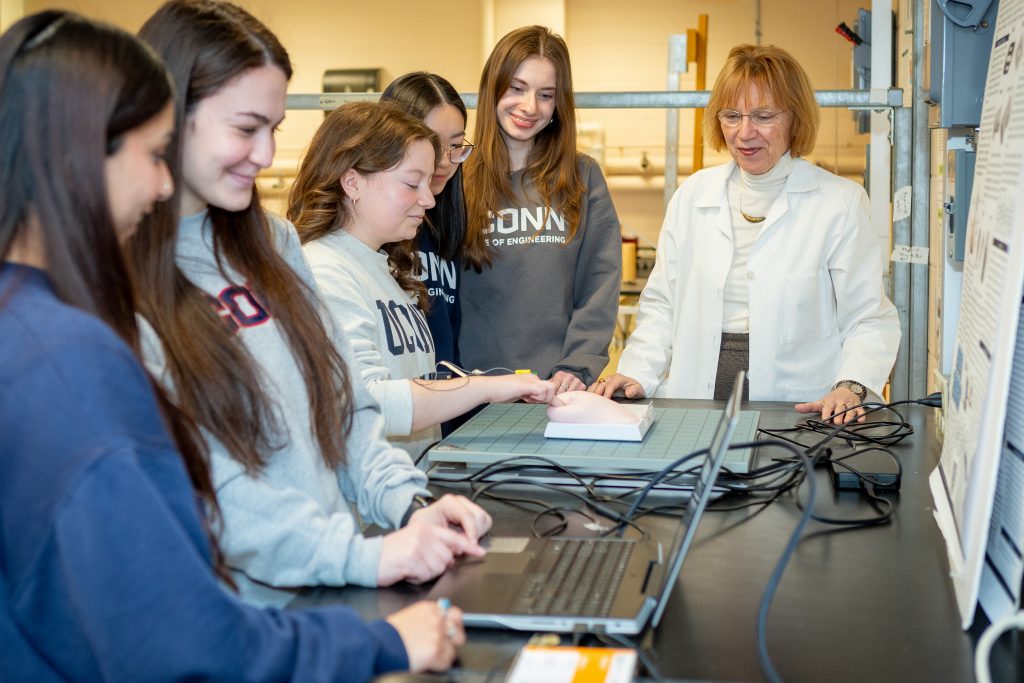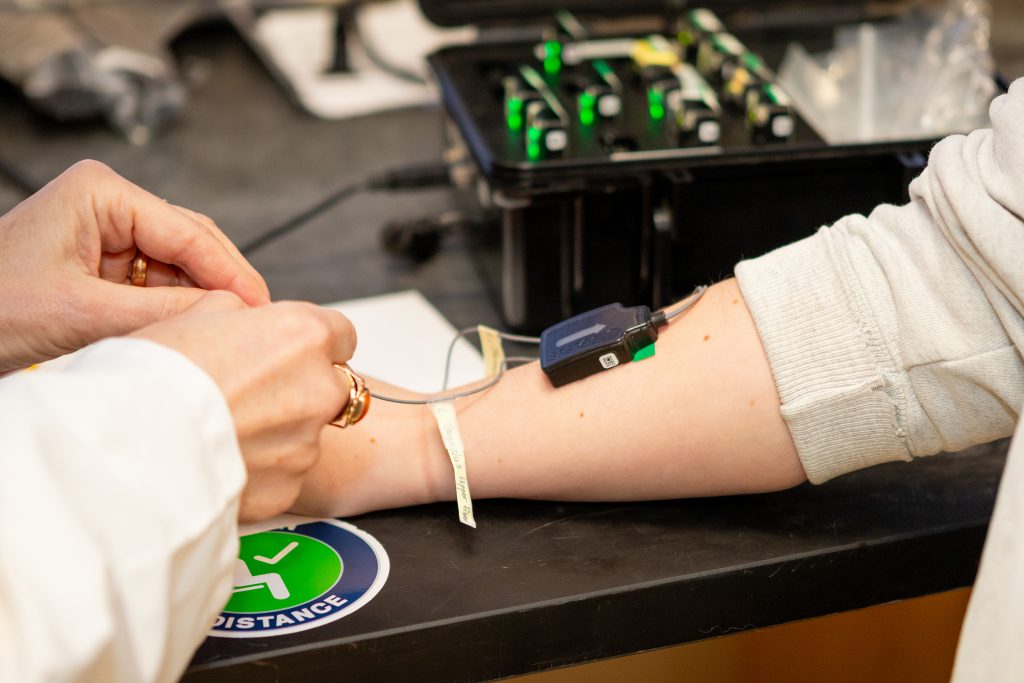Senior Design Team Develops Personalized Breast Self-Exam Virtual Reality Training Simulator
Breast cancer continues to be the leading cause of cancer deaths among women in the U.S., but a UConn Senior Design team’s breakthrough in virtual reality technology could improve access to early detection and, ultimately, save lives.
“Timely detection is critical in successful treatment of the disease, but common diagnostic tests such as mammograms and MRIs can be expensive and difficult for many populations to access,” explains UConn student Carrie Nguyen ’25. “Medical professionals recommend that women perform breast self-exams to check for common breast cancer symptoms such as lumps or skin changes, but some women may lack the knowledge regarding proper technique and symptoms to look for.”
Shame, embarrassment, and discomfort related to the topic also contribute to these challenges, she says.
Motivated to address these barriers, Nguyen and her teammates—Erin Blaszak ’25, Grace Bonacci ’25, Gabriella Bosh ’25, and Abhishree Kaushik ’25, are developing a cutting-edge VR simulator designed to empower women with the skills and confidence needed to conduct effective self-exams. The team will present their prototype at UConn’s 2025 Senior Design Demonstration Day, held May 2 at Gampel Pavilion.
Krystyna Gielo-Perczak, associate professor in residence of biomedical engineering, serves as the team’s faculty advisor.
“The future of biomedical engineering depends on engineers’ ability to contend with challenging biomedical problems and health care needs,” Gielo-Perczak explains. “The challenges ahead are more than any single branch of science can address. Therefore, a multidisciplinary approach is needed to help prepare undergraduate students. Since industrial partners typically do not have time to perform their own first prototype, senior design projects offer a potential solution.”

A Hands-On Training Experience
The team’s self-exam simulator integrates three core components: a virtual reality headset featuring a customized interface, a mechanical glove with haptic feedback, and a microprocessor that detects and calibrates force in a 3D space.
When donning the headset and glove, users enter a virtual environment where they can visualize their hand movements in real-time. A digital breast model appears in the VR interface, allowing users to simulate the process of palpating breast tissue.
“Depending on where you are palpating on the virtual breast, the glove will exert a different level of force onto your fingertips, simulating the feeling of a breast exam with different levels of tissue density,” Nguyen says. “Using this simulator should give you a better idea of what motions to use when performing a breast exam, how much force to apply, and what to look out for.”
To enhance accessibility, the team also developed a step-by-step guide within the simulation, complete with visuals and examples of common breast cancer symptoms. “Contributing to a Senior Design project centered on women’s health has been a meaningful and rewarding experience,” Blaszak says. “I am excited to be making a positive impact in a space that empowers and supports women.”
I attached the smallest EMG sensing head of Trigno Mini EMG sensor to hand. In the back, there is visible a Trigno base station with wireless charging sensors . Yes, it is instrumented/placed on a user before the glove.
Concept to Creation

In 2025, a projected 316,950 women in the U.S. could be diagnosed with invasive breast cancer, and of those, more than 42,000 could die from the disease. Early detection significantly raises the five-year survival rate to an astounding 99%.
These statistics hit home for Leslie Holton, a consultant with medical technology company and Senior Design sponsor Medtronic. While in graduate school studying medical VR applications, Holton lost her mother to metastatic breast cancer.
“My mom and I talked about the importance of breast self-exams, and of course when I visited the doctor, they would also demonstrate them, which was awkward, deeply personal and emotional,” she says.
In November 2023, Holton attended the Medtronic Research Day workshop, organized by Michael DiDonato, business development manager of UConn’s Innovation Partnership Building. There, Holton and Gielo-Perczak discovered a shared passion for advancing women’s health. Holton proposed a visionary concept: a breast self-exam simulator based on individualized medical imaging.
“I told her about my concept, and that with today’s gaming interfaces and other technology it seemed like the time was right to develop this further,” Holton recalls. “The simulator could be deployed in doctors’ offices or brought directly into communities.”
Gielo-Perczak suggested the idea to five senior female biomedical engineering students, who enthusiastically embraced the challenge. UConn alumna Emily Jacobs ’09 (ENG) ’11 MS ’16 Ph.D., a senior principle biomedical engineer for Medtronic, agreed to be the local liaison for the project.
The initial project brief called for a haptic glove capable of delivering tactile feedback, a 3D visual interface, and the use of a real patient’s medical imaging data.
First, the team obtained an MRI scan of a tumorous breast. By using the programming platform MATLAB, the students “mapped” different densities of breast tissue within the 3D image and measured the force needed to palpate different types of tissue.
Next, the team designed the mechanical glove equipped with inertial measurement units, or IMUs, on the index, middle, and ring fingertips to track their movement. The glove uses a sophisticated combination of microprocessors, balloons, air pumps, air valves, and double relay modules to exert force onto the fingertips, simulating the feeling of a breast exam.
Finally, they developed software and programmed a Meta Quest 3S virtual reality headset to display an interactive virtual training space.
“I am absolutely impressed with what the students have accomplished,” Holton says.
A Multidisciplinary Approach

While all five students are biomedical engineering majors, each brings unique skills to the table.
“We all have different experiences with electrical, mechanical, and materials engineering, which complement each other well,” says Nguyen, who’s focusing on imaging and bioinstrumentation.
Bonacci, who’s concentrating on biomechanics and mechanobiology, admittedly has “taken a lot of mechanical engineering classes,” however she only had introductory-level knowledge of coding with C+ and image processing. Creating the virtual reality interface, in particular, helped broaden her background in new areas of engineering.
“This [Senior Design] project is exciting because it allows a chance to contribute to improving access to breast health education, an area that is often underrepresented in the broader medical community.” — Grace Bonacci ’25
“The Senior Design experience will help me become a more well-rounded engineer,” she says. “This project is exciting because it allows a chance to contribute to improving access to breast health education, an area that is often underrepresented in the broader medical community.”
Similarly, Blaszak, who also is concentrating in biomechanics and mechanobiology, discovered that designing the circuit board and troubleshooting the programmable board integration provided an extra challenge.
“Through this project, I’ve learned to manage my time effectively in a team setting and adapt quickly when things do not go according to the plan,” Blaszak says. “This experience has not only given me valuable hands-on skills but has also prepared me for my future career in engineering with greater confidence, organization, and teamwork skills.”
Looking Ahead
As the team nears the end of the academic year, they’re working with the UConn Engineering Electronics Shop to finalize their working prototype in anticipation of Senior Design Demo Day.
“Future iterations of this design will improve upon the initial working prototype to increase the accuracy and sensitivity of the device,” Nguyen explains.
Latest UConn Today
- Two UConn School of Nursing Students Attend a ‘Once in a Lifetime’ Conference Visiting State Senators and Representatives on Capitol HillA different side to the nursing profession.
- UConn Health Half Marathon: Motivational Mantras That WorkLong distance running is a challenge both physically and mentally. Some runners use phrases or “mantras” to keep them focused on the present and to build resilience on especially difficult runs. UConn Health internal medicine physician, Jennifer Ozimek, has run the UConn Health Half Marathon in Simsbury for the past 5 years and has several […]
- CoE Group Shares Fuel Cell Aviation Research, Networks at DOE Energy SummitA UConn team joined energy scientists, technologists, engineers, and industry leaders at the Advanced Research Projects Agency-Energy (ARPA-E) Innovation Summit to collaborate on the future of energy innovation
- Commencement Student Speaker Spotlight: Kristina DuboisDubois is a DMD candidate in the UConn School of Dental Medicine and is a student speaker for UConn Health’s 54th Commencement on May 12, 2025
- Imagine Shakespeare in Front of a PS4 – Probably Not, But the Bard Has Influenced Gaming'Not all literature is so easily translated into new forms and new media. Most of Shakespeare can be adapted to pretty much any time and place'
- From UConn to the White House: A Conversation with Anita McBride ’81 (CLAS)An expert on America’s first ladies, McBride recently returned to UConn to share insights on leadership, public service, and navigating complex challenges with current students













